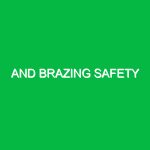Cutting, in the context of the Health, Safety, and Environment (HSE) domain, encompasses a wide array of activities involved in the division or removal of materials. This can range from simple tasks like cutting paper to more complex operations involving heavy machinery in industrial settings. Understanding cutting is crucial, not only because it is integral to many industries, such as construction, manufacturing, and metalworking, but also due to the potential hazards it presents. In this article, we will explore the various risks associated with cutting, safety precautions, best practices, and relevant regulations to ensure a safer workplace.
Understanding Cutting and Its Relevance in HSE
Cutting refers to the process of dividing materials using various tools, such as knives, saws, lasers, or water jets. The relevance of cutting in HSE cannot be overstated; it plays a fundamental role in numerous sectors, including construction, manufacturing, automotive, and healthcare. Each of these fields employs different cutting techniques, and understanding the associated risks is essential for maintaining a safe working environment.
For instance, during my tenure in a manufacturing plant, I witnessed firsthand the importance of proper cutting procedures. A colleague, unaware of the risks, attempted to cut metal sheets without the appropriate protective gear. The resulting injury emphasized how crucial it is to prioritize safety in cutting operations. This incident reinforced my understanding that cutting, while a common task, requires meticulous attention to safety protocols.
Potential Hazards and Risks Associated with Cutting
Cutting introduces various hazards that can lead to injuries or accidents. Understanding these potential risks is the first step in preventing them. Here are some of the most common hazards associated with cutting:
1. Sharp Objects
Tools used for cutting, such as knives or saw blades, are inherently sharp. Accidental contact can result in cuts, lacerations, or puncture wounds. It’s essential to handle these tools carefully and to ensure that they are stored properly when not in use.
2. Flying Debris
When cutting materials, especially with power tools, debris can be ejected at high speeds. This flying debris may cause eye injuries or cuts to exposed skin. The use of appropriate personal protective equipment (PPE), such as safety glasses and gloves, is vital to mitigate this risk.
3. Noise Exposure
Many cutting processes generate significant noise, which can lead to hearing loss over time. Prolonged exposure to loud sounds from cutting machinery necessitates the use of hearing protection, such as earplugs or earmuffs, to safeguard workers’ auditory health.
4. Chemical Exposure
In some situations, cutting involves materials that may emit harmful fumes or dust. For example, cutting certain plastics can release toxic substances. Proper ventilation and respiratory protection are essential to minimize exposure to these hazardous materials.
5. Equipment Malfunction
Using cutting machinery that is poorly maintained can lead to malfunctions and accidents. Regular inspections and maintenance are critical to ensure equipment operates safely and efficiently.
Safety Precautions and Best Practices for Cutting Operations
Implementing safety precautions is crucial to reduce risks associated with cutting. Here are several best practices that can help maintain a safe working environment:
1. Training and Awareness
All employees should receive thorough training on the safe use of cutting tools and equipment. This training should cover proper techniques, hazard recognition, and emergency procedures. Regular refresher courses can help reinforce this knowledge and keep safety at the forefront of workers’ minds.
2. Personal Protective Equipment (PPE)
Employers should provide the necessary PPE, including gloves, safety goggles, face shields, and ear protection. Workers must be trained to use this equipment properly and understand its importance in preventing injuries.
3. Proper Tool Selection
Using the right tool for a specific cutting task is critical. Each tool has a designated purpose, and using it incorrectly can increase the risk of accidents. For instance, using a utility knife to cut thick materials may lead to tool failure and injury.
4. Maintain a Clean Workspace
A cluttered work area can lead to accidents. Keeping the cutting area clean and organized helps prevent tripping hazards and allows for better access to tools and materials. Regularly disposing of debris and waste materials is also essential in maintaining safety.
5. Implement Safety Protocols
Establishing clear safety protocols for cutting operations can significantly reduce risks. These protocols may include procedures for handling materials, using equipment, and reporting unsafe conditions. Regularly reviewing and updating these protocols ensures they remain effective and relevant.
6. Emergency Preparedness
In any cutting operation, accidents can happen. Having a well-defined emergency response plan in place ensures that employees know how to react quickly and effectively in the event of an incident. This plan should include first aid procedures, emergency contact numbers, and evacuation routes.
Regulations and Standards Governing Cutting in HSE
To ensure safety in cutting operations, various regulations and standards apply across different industries. Familiarity with these regulations is crucial for compliance and the overall safety of the workplace. Some key regulations include:
1. OSHA Standards
The Occupational Safety and Health Administration (OSHA) provides regulations that govern workplace safety, including cutting operations. Specific standards address the safe use of tools, PPE requirements, and general safety practices. Employers are responsible for ensuring compliance with these regulations to protect their workers.
2. ANSI Standards
The American National Standards Institute (ANSI) develops standards that promote safety in various industries. ANSI standards related to cutting tools and machinery establish guidelines for safe operation, maintenance, and employee training.
3. ISO Standards
The International Organization for Standardization (ISO) offers a series of standards that address quality, safety, and efficiency in cutting operations globally. These standards encourage best practices and promote continuous improvement in workplace safety.
Conclusion
Cutting is an essential operation across numerous industries, but it carries inherent risks. Understanding the potential hazards and implementing appropriate safety precautions is vital for protecting workers. Training, effective use of PPE, and adherence to regulations can significantly reduce the likelihood of accidents. By prioritizing safety in cutting operations, organizations can foster a culture of health and safety, ultimately leading to a more productive and secure workplace.
As we move forward, let us remember the lessons learned from past incidents and continuously strive to improve safety practices within our cutting operations. By doing so, we not only protect ourselves but also contribute to a safer work environment for everyone.


